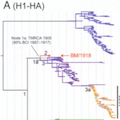Abstract
Pandemic influenza viruses cause significant mortality in humans. In the 20th century, 3 influenza viruses caused major pandemics: the 1918 H1N1 virus, the 1957 H2N2 virus, and the 1968 H3N2 virus. These pandemics were initiated by the introduction and successful adaptation of a novel hemagglutinin subtype to humans from an animal source, resulting in antigenic shift. Despite global concern regarding a new pandemic influenza, the emergence pathway of pandemic strains remains unknown. Here we estimated the evolutionary history and inferred date of introduction to humans of each of the genes for all 20th century pandemic influenza strains. Our results indicate that genetic components of the 1918 H1N1 pandemic virus circulated in mammalian hosts, i.e., swine and humans, as early as 1911 and was not likely to be a recently introduced avian virus. Phylogenetic relationships suggest that the A/Brevig Mission/1/1918 virus (BM/1918) was generated by reassortment between mammalian viruses and a previously circulating human strain, either in swine or, possibly, in humans. Furthermore, seasonal and classic swine H1N1 viruses were not derived directly from BM/1918, but their precursors co-circulated during the pandemic. Mean estimates of the time of most recent common ancestor also suggest that the H2N2 and H3N2 pandemic strains may have been generated through reassortment events in unknown mammalian hosts and involved multiple avian viruses preceding pandemic recognition. The possible generation of pandemic strains through a series of reassortment events in mammals over a period of years before pandemic recognition suggests that appropriate surveillance strategies for detection of precursor viruses may abort future pandemics.
